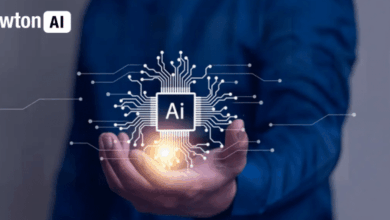DeepMind’s Michelangelo Benchmark: Revealing the Limits of Long-Context LLMs

As artificial intelligence (AI) continues to evolve, the ability to process and understand long strings of information becomes increasingly important. AI systems are now being used for complex tasks such as analyzing long documents, tracking extended conversations and processing large amounts of data. However, many current models struggle with long-context reasoning. As inputs get longer, they often lose track of important details, leading to less accurate or coherent results.
This issue is especially problematic in healthcare, legal services, and finance, where AI tools need to process detailed documents or lengthy discussions while providing accurate, context-aware answers. A common challenge is context driftwhere models lose track of previous information as they process new input, resulting in less relevant results.
To address these limitations, DeepMind has developed the Michelangelo benchmark. This tool rigorously tests how well AI models handle long-context reasoning. Inspired by artist Michelangelo, known for revealing complex sculptures from marble blocks, the benchmark helps discover how well AI models can extract meaningful patterns from large data sets. By identifying where current models fall short, the Michelangelo Benchmark will lead to future improvements in AI’s ability to reason across long contexts.
Understanding long-context reasoning in AI
Long-context reasoning is about an AI model’s ability to remain coherent and accurate over long strings of text, code, or conversation. Models such as GPT-4 and PaLM-2 perform well with short or medium inputs. However, they need help with longer contexts. As the input length increases, these models often lose sight of essential details from previous parts. This leads to errors in understanding, summarizing or making decisions. This problem is known as context window limitation. The model’s ability to retain and process information decreases as the context lengthens.
This problem is significant in real-world applications. In legal services, for example, AI models analyze contracts, case studies or regulations that can be hundreds of pages long. If these models cannot effectively store and reason about such long documents, they may miss key clauses or misinterpret legal terms. This can lead to incorrect advice or analyses. In healthcare, AI systems must synthesize patient records, medical histories, and treatment plans that span years or even decades. If a model cannot accurately recall critical information from previous data, it may recommend inappropriate treatments or misdiagnose patients.
While there have been attempts to improve model token limits (such as GPT-4 processing to 32,000 tokensabout 50 pages of text), reasoning in the long context is still a challenge. The context window problem limits the amount of input a model can process and affects its ability to maintain accurate understanding throughout the entire input sequence. This leads to context drift, where the model gradually changes Forgets earlier details as new information is introduced. This reduces its ability to generate coherent and relevant results.
The Michelangelo Benchmark: concept and approach
The Michelangelo Benchmark addresses the challenges of long-context reasoning by testing LLMs on tasks that require them to retain and process information over longer sequences. Unlike previous benchmarks, which focus on short-context tasks such as completing sentences or answering simple questions, the Michelangelo Benchmark emphasizes tasks that challenge models to reason across long data sets, often including inferences or irrelevant information.
The Michelangelo Benchmark challenges AI models using the Latent Structure Query (LSQ) Framework.. This method requires models to find meaningful patterns in large data sets while filtering out irrelevant information, similar to how humans sift through complex data to focus on what’s important. The benchmark focuses on two main areas: natural language and code, introducing tasks that test more than just data retrieval.
An important task is the latent list task. In this task, the model is given a series of Python list operations, such as adding, removing, or sorting elements, and then it must produce the correct final list. To make it even more difficult, the task contains irrelevant operations, such as reversing the list or canceling previous steps. This tests the model’s ability to focus on critical operations, simulating how AI systems should handle large data sets with mixed relevance.
Another crucial task is Multi-Round Co-reference Resolution (MRCR). This task measures how well the model can follow references in long conversations with overlapping or unclear topics. The challenge for the model is to connect references made late in the conversation to earlier points, even if those references are hidden under irrelevant details. This task mirrors real-world discussions, where topics change frequently, and AI must accurately track and resolve references to maintain coherent communication.
In addition, Michelangelo features the IDK task, which tests a model’s ability to recognize when it does not have enough information to answer a question. In this task, the model is presented with text that may not contain the relevant information to answer a specific question. The challenge is that the model identifies cases where the correct answer is “Don’t know‘ instead of giving a plausible but incorrect answer. This task reflects a crucial aspect of AI reliability: recognizing uncertainty.
With these types of tasks, Michelangelo goes beyond simple data retrieval. He tests a model’s ability to reason, synthesize and manage long-context input. It introduces a scalable, synthetic, and unleaked benchmark for long-context reasoning, providing a more accurate measure of the current state and future potential of LLMs.
Implications for AI research and development
The results of the Michelangelo Benchmark have significant implications for the way we develop AI. The benchmark shows that current LLMs need better architecture, especially in the area of attention mechanisms and memory systems. Currently, most LLMs rely on self-attention mechanisms. These are effective for short tasks, but struggle when the context increases. This is where we see the problem of context drift, where models forget or mix up previous details. To solve this, researchers are investigating models with memory enhancement. These models can store important information from earlier parts of a conversation or document so that the AI can recall and use it when necessary.
Another promising approach is hierarchical processing. This method allows the AI to break down lengthy input into smaller, manageable chunks, allowing it to focus on the most relevant details at each step. This way, the model can better handle complex tasks without being overwhelmed by too much information at once.
Improving long-context reasoning will have a significant impact. In healthcare, this could mean better analysis of patient records, where AI can track a patient’s history over time and provide more accurate treatment recommendations. In legal services, these developments could lead to AI systems that can analyze long contracts or case law with greater accuracy, helping lawyers and legal professionals gain more reliable insights.
However, these advances also raise critical ethical concerns. As AI gets better at remembering and reasoning about long contexts, there is a risk that sensitive or private information could be exposed. This is a real concern for industries like healthcare and customer service, where confidentiality is critical.
If AI models remember too much information from previous interactions, they can inadvertently reveal personal details in future conversations. Additionally, as AI becomes better at generating persuasive long-form content, there is a danger that it could be used to create more sophisticated disinformation or misinformation, further complicating the challenges surrounding AI regulation.
The bottom line
The Michelangelo Benchmark has provided insights into how AI models manage complex, long-context tasks, highlighting their strengths and weaknesses. This benchmark promotes innovation as AI evolves, encouraging better model architecture and improved memory systems. The potential for transforming sectors such as healthcare and legal services is exciting, but comes with ethical responsibilities.
Concerns about privacy, disinformation and fairness need to be addressed as AI becomes increasingly adept at processing large amounts of information. The growth of AI must remain focused on benefiting society thoughtfully and responsibly.






